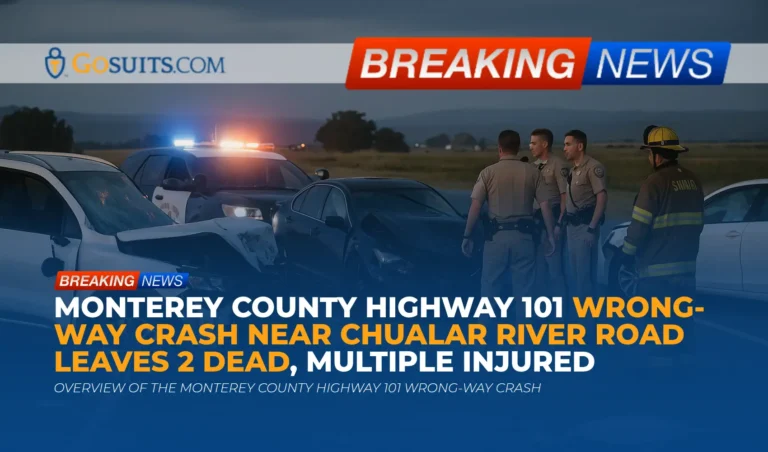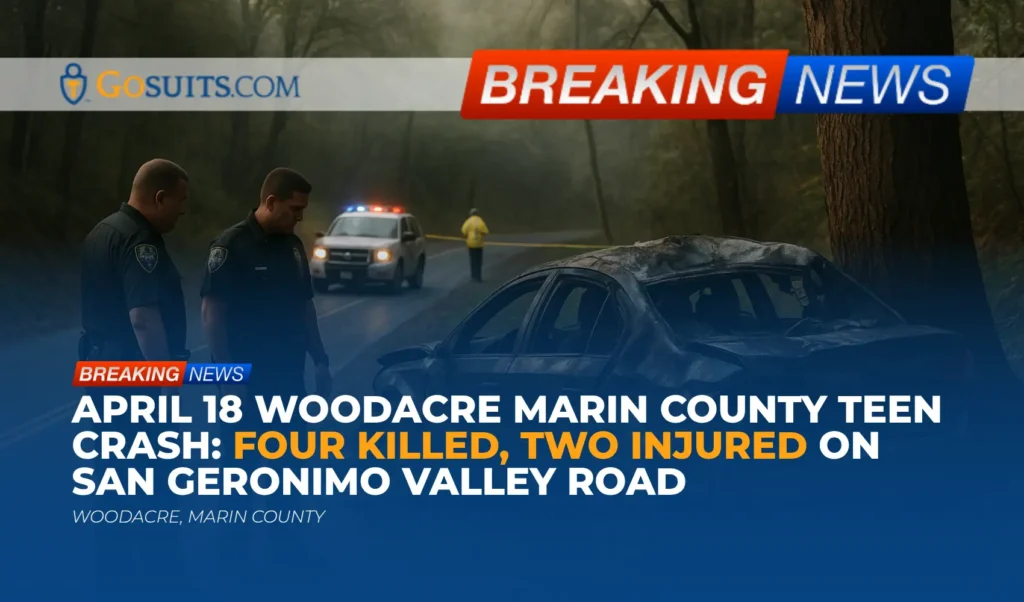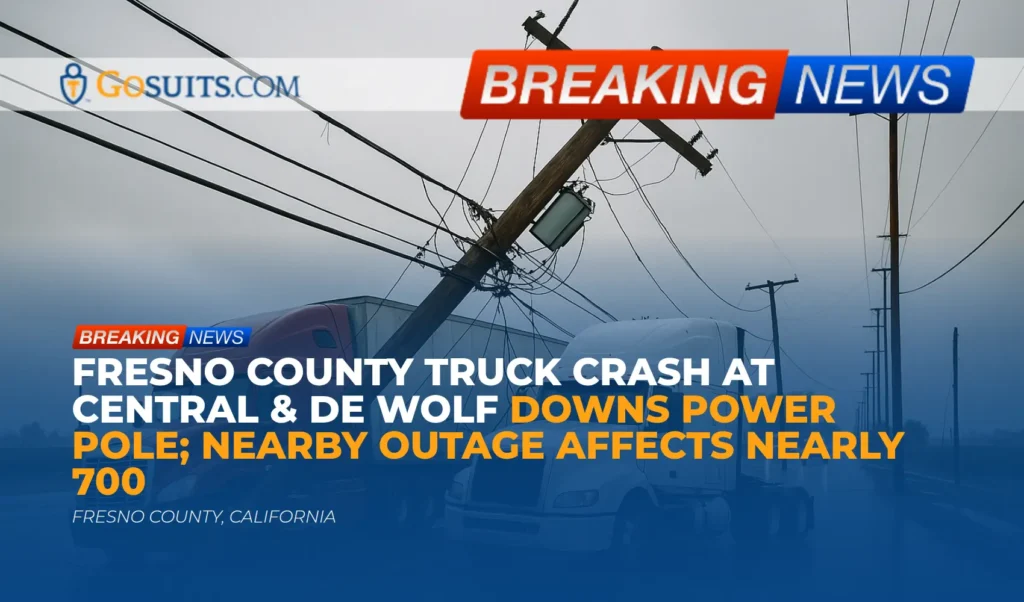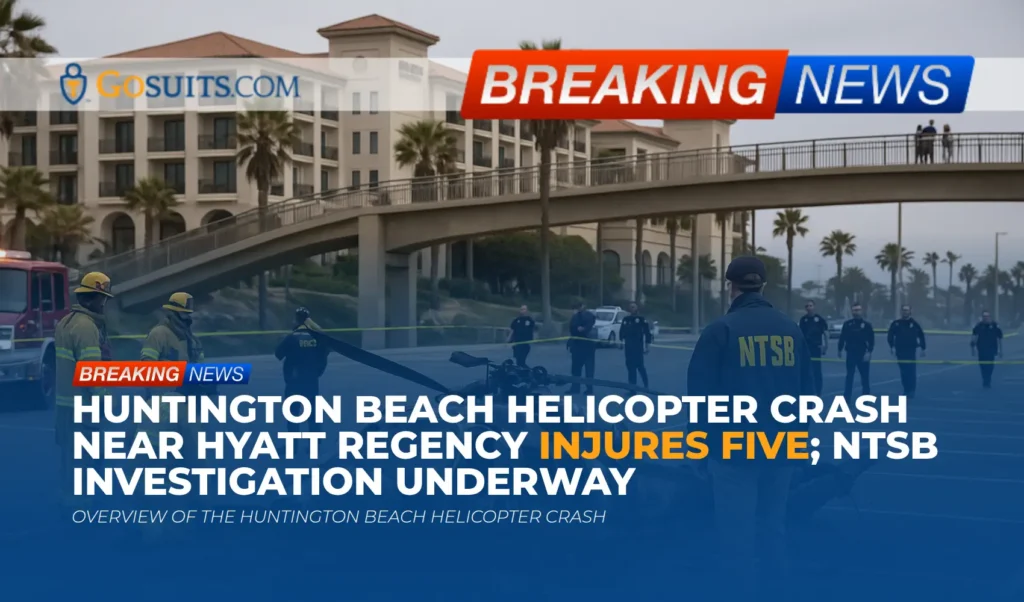- Overview of the Monterey County Highway 101 Wrong-Way Crash
- What We Know About Those Involved
- Safety Context: Why Wrong-Way Crashes Are So Dangerous
- Potential Civil Liability and Rights Under California Law
- Insurance Considerations After a Wrong-Way Collision
- Key Evidence to Secure and How to Get Official Records
- Steps to Take Next: Health, Documentation, and Communication
- How Long Do You Have? Key Filing Deadlines in California
- Counseling, Financial, and Community Support Resources
- Commentary from Gosuits Monterey County, California Personal Injury Attorney
- Time-Sensitive Action Checklist
Overview of the Monterey County Highway 101 Wrong-Way Crash
Authorities report a tragic wrong-way collision in Monterey County that resulted in two fatalities and multiple injuries. The California Highway Patrol stated the three-vehicle crash occurred at approximately 6:49 p.m. on a Sunday night on southbound Highway 101, just south of the Chualar River Road overcrossing. According to the initial information, a white Kia SUV traveling north in the southbound lanes collided head-on with a black Honda sedan. The impact triggered a secondary crash involving a white Toyota sedan. Both sedans were headed the correct direction. The drivers of the Kia SUV and the Honda sedan were pronounced deceased at the scene. Three passengers in the Kia were transported to a hospital with injuries described as ranging from minor to major. The investigation is ongoing, and it has not yet been determined whether alcohol was a factor. The Monterey County Sheriff’s Office will release the identities of the deceased after notifying next of kin.
What this means for families and survivors
In the immediate aftermath of a high-energy, wrong-way crash, families and survivors often face sudden loss, trauma, hospital bills, missed work, and questions about fault and insurance. While investigators work to determine the precise cause, there are steps that can protect safety, preserve evidence, and safeguard legal rights. This article is intended to offer clear, compassionate information and point to official resources that may help during a difficult time.
What We Know About Those Involved
Based on the available details from law enforcement statements at the scene:
- Vehicles and directions: The initial collision involved a white Kia SUV traveling the wrong way (northbound in southbound lanes) and a black Honda sedan traveling in the correct direction. A secondary impact then involved a white Toyota sedan, also traveling correctly.
- Individuals: The wrong-way Kia was driven by a 41-year-old Salinas man and carried three passengers. The Honda was driven by a 46-year-old Arizona resident. The Toyota was driven by a 29-year-old Salinas resident.
- Injuries and fatalities: The drivers of the Kia SUV and the Honda sedan died at the scene. The Kia’s passengers suffered injuries ranging from minor to major and were transported for medical care.
- Status of investigation: The California Highway Patrol is investigating. It is not yet known whether impairment or other factors contributed. The Monterey County Sheriff-Coroner will release identities after notifying family.
Safety Context: Why Wrong-Way Crashes Are So Dangerous
Wrong-way collisions on high-speed, divided highways are among the most catastrophic roadway events. They typically occur as head-on impacts at freeway speeds, concentrating extreme forces on occupants. National safety agencies have studied these crashes for years and consistently report disproportionately severe outcomes.
- Severity: The National Transportation Safety Board has noted that although wrong-way crashes are relatively infrequent compared to other crash types, they are much more likely to be fatal because they often involve head-on impacts on high-speed roads. See the NTSB’s special investigation of wrong-way driving for background and countermeasures guidance: NTSB Wrong-Way Driving Special Investigative Report.
- Countermeasures: Transportation agencies including the Federal Highway Administration and Caltrans have implemented strategies such as better ramp signing, red reflective markers oriented toward wrong-way entrants, high-visibility “Do Not Enter” and “Wrong Way” signs, and pilot programs testing detection systems with alerts to motorists and dispatch. See Caltrans’ overview of its wrong-way driving efforts: Caltrans Wrong-Way Driving.
These countermeasures aim to reduce the likelihood of wrong-way entries and, when they occur, to detect them quickly. Even with improvements, driver behavior and moment-to-moment decisions remain decisive factors, which is why thorough investigations look at roadway features, signage, lighting, vehicle data, and human factors such as distraction, fatigue, and potential impairment.
Potential Civil Liability and Rights Under California Law
When a driver travels the wrong direction on a divided highway and causes a collision, civil liability commonly turns on negligence and compliance with California traffic laws. While every case depends on its evidence, several legal principles frequently apply in high-speed wrong-way crashes.
Negligence and negligence per se
- Wrong-way driving on divided highways: California law prohibits driving on the wrong side of a divided highway and entering or exiting at unauthorized points. See California Vehicle Code section 21651: CVC §21651.
- Negligence per se: When a person violates a statute designed to protect the public and that violation causes the type of harm the statute was meant to prevent, a jury may treat the violation as evidence of negligence. See California Evidence Code section 669: Evidence Code §669.
- Comparative fault: California uses comparative fault principles, meaning a jury can assign percentages of responsibility to each party whose conduct contributed to an injury. The Judicial Council’s Civil Jury Instructions reflect this framework: California Civil Jury Instructions (CACI).
In a typical wrong-way scenario, the wrong-way driver is the primary focus of fault assessment. However, investigations sometimes consider additional factors such as signage visibility, roadway lighting, or median barrier design. Claims against public entities involve specific rules and defenses, and any evaluation must rely on evidence from the scene, roadway plans, and expert analysis.
Wrongful death and survival claims
- Wrongful death claims: Certain family members may bring a wrongful death claim under California Code of Civil Procedure section 377.60, which identifies who can file and what losses may be claimed. See the statute here: CCP §377.60.
- Survival actions: The decedent’s estate may assert limited claims the decedent could have pursued had they lived, separate from wrongful death claims by heirs. These claims are time-sensitive and evidence-dependent.
- Injury claims for survivors: Occupants injured in any of the vehicles may pursue personal injury claims for medical care costs, lost income, and other legally recognized damages.
Every claim is different, and outcomes depend on the facts, available insurance, and proof connecting the crash to the losses claimed.
Insurance Considerations After a Wrong-Way Collision
Insurance issues after a catastrophic freeway crash can be complex, especially when multiple vehicles, out-of-state drivers, and severe injuries are involved. These are common coverage avenues that typically come into play:
- Liability coverage of the at-fault driver: Bodily injury and property damage liability cover claims brought by injured parties and families of those killed, up to policy limits. In a wrong-way scenario, the wrong-way driver’s policy is often the primary source of recovery for others harmed.
- Underinsured and uninsured motorist (UM/UIM): If the at-fault driver has no insurance, or not enough insurance, injured parties and families may seek benefits under their own UM/UIM coverage. These claims have notice and proof requirements; statements made to insurers can affect outcomes.
- MedPay and health insurance: Medical payments coverage can help with initial medical expenses regardless of fault. Health insurance may cover treatment, but insurers often assert reimbursement rights from any later recovery.
- Out-of-state factors: When a driver is from another state, choice-of-law and venue questions may arise. Crashes occurring in California are generally handled under California law, but the language of insurance policies and the facts can influence where and how claims proceed.
Before contacting any insurance carrier to provide recorded statements, it is prudent to consult a seasoned attorney for a free consultation to understand rights and obligations. Insurers routinely record statements and use details later in evaluating or disputing claims.
Key Evidence to Secure and How to Get Official Records
Evidence can fade quickly after freeway crashes. Preserving records early can make a meaningful difference in understanding what happened and in supporting insurance claims later. The following are standard sources and how to request them from official agencies.
CHP collision report
- What it is: The primary investigative report documenting the scene, involved parties, preliminary findings, and often a diagram.
- How to request: The California Highway Patrol uses the CHP 190 form for collision report requests. Instructions and the request form are available here: CHP: How to Request a Collision Report and the form itself here: CHP 190 PDF.
- What you need: Date and time, location (southbound Highway 101 just south of the Chualar River Road overcrossing), the involved vehicle(s), and your relationship to the parties.

Monterey County Sheriff-Coroner records
- Identification and next-of-kin notification: The Sheriff-Coroner releases names after families are notified.
- Coroner and autopsy records: Depending on status and authorization, certain reports may be available to legal next of kin. See the county’s Sheriff-Coroner information page: Monterey County Sheriff-Coroner.
- Death certificates: Certified copies can be obtained through the California Department of Public Health’s Vital Records. See: CDPH Vital Records.
911 audio, dispatch logs, and roadway video
- 911 and CAD (computer-aided dispatch): In some cases, requesters may seek 911 recordings and dispatch logs. These are subject to the California Public Records Act and confidentiality provisions. The specific agency (CHP or county emergency communications) will advise on availability and process.
- Caltrans traffic cameras and detection systems: Caltrans may maintain limited roadway data and footage. Availability and retention are restricted. For public records guidance, see: Caltrans Public Records Act Requests.
Medical records
- Access to your records: Patients have a right to access their medical records under federal law. See HHS information on the right of access: HHS HIPAA Right to Access.
- Why they matter: Hospital records, imaging, and discharge summaries document injuries, causation, and costs.
Vehicle and scene evidence
- Vehicle preservation: Vehicles often contain critical data (e.g., event data recorders), crush patterns, and restraint evidence. Promptly identify where vehicles are stored.
- Scene documentation: Photographs of debris fields, skid marks, lane markings, signage, and lighting can be invaluable.
- Witness information: Collect names and contact information for any witnesses identified in the report or at the scene.
Steps to Take Next: Health, Documentation, and Communication
- Prioritize medical care and follow-ups: Seek evaluation and follow provider recommendations. Keep all discharge papers, prescriptions, and appointment records.
- Organize documentation: Start a file for bills, receipts, wage loss proof, and insurance correspondence. This organization supports both health insurance claims and any later liability or UM/UIM claims.
- Be cautious with insurance statements: Before providing any recorded statement to an insurer, consult an attorney for a free consultation. What is said to adjusters can be used later to limit or deny claims.
- Avoid social media discussion of the crash: Public posts can be misinterpreted and may be reviewed by insurers.
- Request essential records early: Obtain the CHP collision report and, where appropriate, coroner records and death certificates. Early requests can prevent delays that slow insurance evaluations.
How Long Do You Have? Key Filing Deadlines in California
- Personal injury and wrongful death: Generally two years from the date of the incident to file a civil action. See California Code of Civil Procedure section 335.1: CCP §335.1.
- Claims involving public entities: A written government claim typically must be presented within six months for personal injury or wrongful death, before filing a lawsuit. See Government Code section 911.2: Gov. Code §911.2.
Deadlines can be affected by many factors. Evaluating them early helps avoid losing rights due to timing.
Counseling, Financial, and Community Support Resources
Severe crashes can overwhelm families emotionally and financially. These official resources may help:
- California Victim Compensation Board (CalVCB): Provides financial assistance to eligible victims and families for certain expenses, including funeral and burial costs in qualifying circumstances. Learn more at: California Victim Compensation Board.
- Behavioral health and grief support: Monterey County Behavioral Health can connect residents with counseling and crisis resources. County programs and contacts are listed on the Monterey County website: Monterey County.
- Substance use and mental health national helpline: The federal SAMHSA Helpline offers free, confidential support 24/7 at 1-800-662-HELP (4357). Program information is available at: SAMHSA Helpline.
Support services can be an anchor during the first weeks and months after a sudden loss or life-changing injury.
Commentary from Gosuits Monterey County, California Personal Injury Attorney
Our hearts go out to everyone affected by this devastating wrong-way crash on Highway 101. The information here is offered for education and general awareness. It cannot capture the full weight of what the families and survivors are facing, but we hope it provides a clearer path through the procedural and practical steps that often follow.
Based on the reported facts, a vehicle traveling the wrong way on a divided highway appears to have initiated a head-on collision, followed by a secondary impact. California law forbids wrong-way travel on divided highways, and such conduct is routinely central to civil fault assessments. While investigators will determine contributing factors, including signage and any human factors, the risk profile of a wrong-way, high-speed collision is well recognized by safety agencies.
In our experience, large insurers and corporations may act quickly to record statements, gather documents, and shape the narrative of a claim. Their adjusters are trained to ask questions in ways that can minimize payouts or shift responsibility. Seemingly small details mentioned early can have outsized effects months later. Understanding what documents to request, how to preserve evidence, and when to decline a recorded statement without guidance can help balance that asymmetry.
Speaking with a seasoned injury attorney before engaging with insurers can level the playing field. A free consultation allows people to understand timelines, evidence needs, and potential coverage paths without cost or obligation. That early knowledge often prevents missteps that might otherwise limit options later.

Time-Sensitive Action Checklist
The following immediate actions help protect safety, preserve evidence, and support any insurance process that may unfold:
- Obtain the CHP collision report number and request the full report. Record the exact date, time, and location. Include proof of your relationship or involvement when submitting the request form.
- Preserve vehicles and personal items involved in the crash. Avoid authorizing disposal or repairs until evidence is documented. Ask the tow yard or storage facility to hold the vehicle.
- Secure medical documentation. Keep discharge instructions, imaging, prescriptions, and follow-up referrals. Track all out-of-pocket costs.
- Collect proof of income and missed work. Pay stubs, employer letters, and tax documents can substantiate wage loss.
- Document injuries and recovery. Photographs over time and a simple pain-and-activity journal can help depict the course of recovery.
- Identify and contact witnesses. Preserve names and contact details for anyone who saw the crash or its aftermath.
- Request coroner and vital records where appropriate. Families may seek coroner findings and certified death certificates for administrative and insurance needs.
- Do not provide recorded statements to insurers before speaking with an attorney. Initial statements can shape claim outcomes; a free consultation first helps clarify rights and risks.
- Calendar key deadlines. Note the two-year general statute for personal injury and wrongful death and the six-month government claim requirement where applicable.
- Consider roadway and video evidence requests early. Traffic camera footage and dispatch audio may be subject to short retention periods, so prompt requests are important.
Acting promptly can make a concrete difference: evidence is preserved, deadlines are met, and the path to benefits or compensation is clearer and less stressful. Even if no decisions are made about pursuing claims, organizing records and understanding options now helps ensure that choices remain available later.
Official References and Resources
- NTSB: Wrong-Way Driving Special Investigative Report
- Caltrans: Wrong-Way Driving Program
- CHP: How to Request a Collision Report
- CHP 190 Collision Request Form (PDF)
- Monterey County Sheriff-Coroner
- California Department of Public Health: Vital Records
- California Vehicle Code §21651 (Divided Highways)
- Evidence Code §669 (Negligence Per Se)
- CCP §377.60 (Wrongful Death)
- CCP §335.1 (2-Year Statute)
- Gov. Code §911.2 (Government Claims)
- California Civil Jury Instructions (CACI)
- Caltrans: Public Records Act Requests
- HHS: HIPAA Right to Access Medical Records
- California Victim Compensation Board
- Monterey County (Official Site)
- SAMHSA National Helpline






